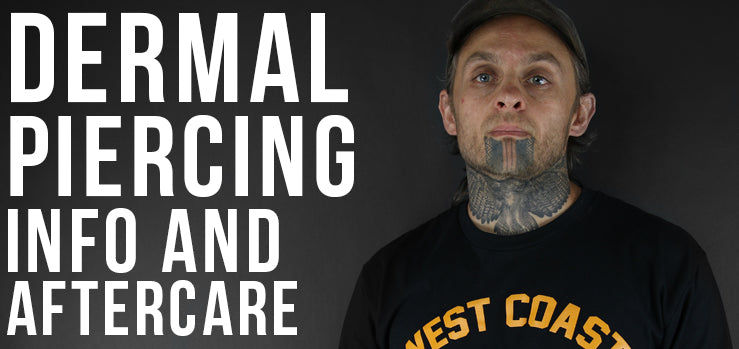Dermal Piercing Information & Aftercare

The term “dermal” covers several different types of jewelry but they are all a type of anchor that is embedded into the skin with a single hole to which jewelry heads can be attached. Dermal anchors are a better choice than surface bars for piercing any area of skin where jewelry cannot be put straight through. They heal well because there is little trauma to the skin. Most professional piercers can change dermal tops quite easily but it can be difficult if you're trying to change it yourself without the right tools and you may accidentally rip it trying to do so.
How is a Dermal Pierced?
Normally dermal piercings are done using a dermal or biopsy punch. This removes a small circle of skin and creates a single hole that the T anchor bar can be slid into. However, recently piercers have been returning to using piercing needles to do dermal piercings because they create less scarring and are less damaging to the skin. Your piercer will mark a small dot where the piercing will sit and then create a single hole using the needle. They will then slide the T bar into the piercing (usually the most painful part) and screw in the head attachment. Your dermal may bleed a little but no more than a “normal” piercing.

Dermal Healing Time
Dermals have a similar healing time to most piercings (about 2-3 months) and it's important not to change the heads during that time as it may disturb the healing process. Healing a dermal is much like any other piercing. You want to leave it alone as much as possible and avoid rotating, turning, or disturbing the jewelry. It should be cleaned using a simple saltwater solution which can also be used as a therapeutic soak for 7-15 minutes. This is mixed with 1 gallon of distilled water and 4 tea spoons of non-iodized sea salt. Do not use hydrogen peroxide, neosporin, or alcohol on your piercing as it can damage the healing.
The dermal bar has small holes in it which allow the skin to grow through and around the piece. This anchors it into your skin. If you move or disturb this that skin does not grow through properly and the anchor will not be held securely. This means that if you try and change the head it may come out or be easily pulled out on accident. It can also cause scar tissue to form.

Dermal Jewelry
Dermal anchors are made of 2 separate parts - a T shaped back and a screw head. Almost all dermal anchors are 14g sized but some may be internally threaded and other heads may be externally threaded depending on brands. It's important if your piercing is somewhere that it is likely to get caught that you buy heads which are as flat as possible for daily wear as this will help prevent it getting ripped out. You'll also want to avoid wearing any heads which are too heavy for long periods as this can cause your piercing to migrate or eventually pull out. There are many different top attachments available for dermals including flat disks, gems, balls, rings, spikes, and shaped tops. You want to avoid leaving your dermal without a top as it is flush with the skin surface and may allow the skin to grow over.
What if it Falls Out?
If your dermal piercing comes out it can often be replaced right back into the original hole if you get it back in immediately. Depending on the amount of damage and reason that it came out you may have to let the area heal up again first and have it repierced. Most piercers will need to use new, sterile jewelry when doing so to reduce the risk of infection where your skin has been damaged from it being ripped out.
If you want it removed your piercer can take it out easily using special tools. You will likely have a small scar where the dermal was after it is removed. This is not usually done with a punch as it is unnecessary to punch the skin again and the anchor can be pulled out.



